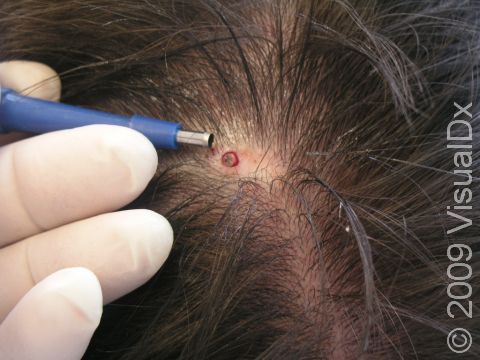Biopsy, Skin
A skin biopsy, where a physician removes a small sample of skin for testing, is a rapid and convenient office procedure that aids in the diagnosis of a patient’s skin condition or lesion. Although usually done by a dermatologist, any physician who is skilled and knowledgeable with the technique and its indications can safely perform a skin biopsy. There are several techniques that involve sampling tissue from a skin lesion or eruption. Once removed, the tissue sample is processed and examined under a microscope by a pathologist. It usually takes several days before a final diagnosis is rendered.
Skin biopsy procedure selection very much depends on the suspected diagnosis, size, and location of the lesion.
Who's At Risk?
A skin biopsy is often necessary when a skin condition cannot be diagnosed by the patient’s history and what the physician finds on examination alone. Confirming a clinical diagnosis may also be necessary prior to starting therapy.
Skin biopsy types are as follows:
- Shave biopsies
- Punch biopsies
- Excisional biopsies
Skin biopsies can also be submitted for tissue culture if the diagnosis of a bacterial or fungal infection is in question.
Any skin lesion can be biopsied. It is important for patients to realize, however, that in some cases, microscopic examination of tissue may be very nonspecific and not necessarily helpful in rendering a specific diagnosis.
Signs & Symptoms
The doctor performing the biopsy may ask in advance about any allergic reactions to anesthetic medications, about any blood thinner or anticoagulant medications you may be taking, or problems with bleeding in the past. Typically, there are no symptoms or conditions in a patient that would cause a physician to not perform a skin biopsy, but these questions help the doctor anticipate and better manage any potential complications (eg, excess bleeding). Otherwise, there is no special preparation needed prior to the procedure.
Once the area of interest is cleansed with alcohol or antiseptic solution, local anesthetic is injected in and around the skin lesion of interest using a syringe topped with a very fine needle. The skin biopsy is performed by the doctor using one of the methods described below, and the tissue removed is then placed in a bottle. Three commonly performed skin biopsy procedures are as follows:
- Shave biopsy – This is a superficial skin biopsy performed by a doctor where a thin layer is shaved off the surface of a lesion.
- Punch biopsy – A doctor removes a cylindrical sample to view layers of a lesion.
- Excisional biopsy – The doctor uses a scalpel to remove the entire visible portion of a lesion.
Self-Care Guidelines
Antibacterial ointment or Vaseline® with a small dressing or Band-Aid® is placed over the wound.
The patient is advised to keep the wound dry for the next 24 hours; thereafter, it may be gently cleaned with soap and water. Applying antibacterial ointment or Vaseline may be done on a daily basis until the wound heals.
Treatments
A skin biopsy may not be necessary before definitive treatment is offered to a patient. The physician may be able to make a judgement on a diagnosis and proper treatment based on other tests or a physical exam. For example, a physician may be able to do what is known as a skin scraping and view the skin cells under a microscope, or a skin culture can be helpful in diagnosing infection.
When to Seek Medical Care
- Bleeding
- Pain
- Infection
- Non-healing wound (this is a greater risk if the biopsy is done on the lower legs)
- Scarring
- Keloid formation
Additionally, biopsies cannot diagnose all skin conditions. As such, a biopsy of a lesion may not necessarily reveal the correct diagnosis.
Trusted Links
Last modified on October 5th, 2022 at 7:02 pm

Not sure what to look for?
Try our new Rash and Skin Condition Finder
